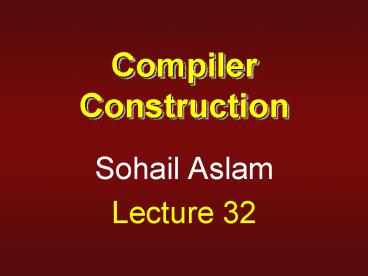Compiler Construction - PowerPoint PPT Presentation
1 / 30
Title:
Compiler Construction
Description:
Compiler Construction Sohail Aslam Lecture 32 Evaluation Methods Dynamic methods Build the parse tree Build the dependence graph Topological sort the graph Define ... – PowerPoint PPT presentation
Number of Views:93
Avg rating:3.0/5.0
Title: Compiler Construction
1
Compiler Construction
- Sohail Aslam
- Lecture 32
2
Parse tree for 101
Number
List
Sign
List
Bit
List
1
Bit
Bit
0
1
3
attributed tree
val -5
Number
pos 0val 5
List
Sign
neg true
pos 1val 4
List
pos 0val 1
Bit
pos 2val 4
pos 1val 0
List
1
Bit
pos 2val 4
Bit
0
1
4
Inherited Attributes
val -5
Number
pos 0val 5
List
Sign
neg true
pos 1val 4
List
pos 0val 1
Bit
pos 2val 4
pos 1val 0
List
1
Bit
pos 2val 4
Bit
0
1
5
Synthesized Attributes
val -5
Number
pos 0val 5
List
Sign
neg true
pos 1val 4
List
pos 0val 1
Bit
pos 2val 4
pos 1val 0
List
1
Bit
pos 2val 4
Bit
0
1
6
Together
val -5
Number
pos 0val 5
List
Sign
neg true
pos 1val 4
List
pos 0val 1
Bit
pos 2val 4
pos 1val 0
List
1
Bit
pos 2val 4
Bit
0
1
7
peel away parse tree
val -5
Number
pos 0val 5
List
Sign
neg true
pos 1val 4
List
pos 0val 1
Bit
pos 2val 4
pos 1val 0
List
1
Bit
pos 2val 4
Bit
0
1
8
dependence graph
val -5
pos 0val 5
neg true
pos 1val 4
pos 0val 1
pos 2val 4
pos 1val 0
1
pos 2val 4
0
1
9
dependence graph
val -5
pos 0val 5
neg true
pos 1val 4
pos 0val 1
pos 2val 4
pos 1val 0
1
pos 2val 4
0
must be acyclic!
1
10
Evaluation Methods
- Dynamic methods
- Build the parse tree
- Build the dependence graph
- Topological sort the graph
- Define attributes in topological order
11
Evaluation Methods
- Dynamic methods
- Build the parse tree
- Build the dependence graph
- Topological sort the graph
- Define attributes in topological order
12
Evaluation Methods
- Dynamic methods
- Build the parse tree
- Build the dependence graph
- Topological sort the graph
- Define attributes in topological order
13
Evaluation Methods
- Dynamic methods
- Build the parse tree
- Build the dependence graph
- Topological sort the graph
- Define attributes in topological order
14
Evaluation Methods
- Dynamic methods
- Build the parse tree
- Build the dependence graph
- Topological sort the graph
- Define attributes in topological order
15
Evaluation Methods
- Rule-based (treewalk)
- Analyze attribute rules at compiler-generation
time - Determine a fixed (static) ordering
- Evaluate nodes in that order
16
Evaluation Methods
- Oblivious (passes, dataflow)
- Ignore rules and parse tree
- Pick a convenient order (at design time) and use
it
17
Problems
- Attribute grammars have not achieved widespread
use due to a myraid of problems
18
Problems
- non-local computation
- traversing parse tree
- storage management for short-lived attributes
- lack of high-quality inexpensive tools
19
Problems
- non-local computation
- traversing parse tree
- storage management for short-lived attributes
- lack of high-quality inexpensive tools
20
Problems
- non-local computation
- traversing parse tree
- storage management for short-lived attributes
- lack of high-quality inexpensive tools
21
Problems
- non-local computation
- traversing parse tree
- storage management for short-lived attributes
- lack of high-quality inexpensive tools
22
Ad-Hoc Analysis
- In rule-based evaluators, a sequence of actions
are associated with grammar productions
23
Ad-Hoc Analysis
- Organizing actions required for context-sensitive
analysis around structure of the grammar leads to
powerful, albeit ad-hoc, approach which is used
on most parsers
24
Ad-Hoc Analysis
- A snippet of code (action) is associated with
each production that executes at parse time - In top-down parsers, the snippet is added to the
appropriate parsing routine
25
Ad-Hoc Analysis
- A snippet of code (action) is associated with
each production that executes at parse time - In top-down parsers, the snippet is added to the
appropriate parsing routine
26
Ad-Hoc Analysis
- In a bottom-up shift-reduce parsers, the actions
are performed each time the parser performs a
reduction.
27
LR(1) Skeleton Parser
- stack.push(dummy) stack.push(0)
- done false token scanner.next()
- while (!done)
- s stack.top()
- if( Actions,token reduce A?b)
- stack.pop(2?b)
- s stack.top()
- stack.push(A)
- stack.push(Gotos,A)
- else if( Actions,token shift i)
- stack.push(token) stack.push(i) token
scanner.next()
28
LR(1) Skeleton Parser
- stack.push(dummy) stack.push(0)
- done false token scanner.next()
- while (!done)
- s stack.top()
- if( Actions,token reduce A?b)
- stack.pop(2?b)
- s stack.top()
- stack.push(A)
- stack.push(Gotos,A)
- else if( Actions,token shift i)
- stack.push(token) stack.push(i) token
scanner.next()
29
LR(1) Skeleton Parser
- if( Actions,token reduce A?b)
stack.pop(2?b) s stack.top()
stack.push(A) stack.push(Gotos,A)
invoke the code snippet
30
Productions Code snippet
Number ? Sign List Number.val ? Sign.val ? List.val
Sign ? Sign.val ? 1
Sign ? Sign.val ? 1
List ? Bit List.val ? Bit.val
List0 ? List1 Bit List0.val ? 2?List1.val Bit.val
Bit ? 0 Bit.val ? 0
Bit ? 1 Bit.val ? 1































